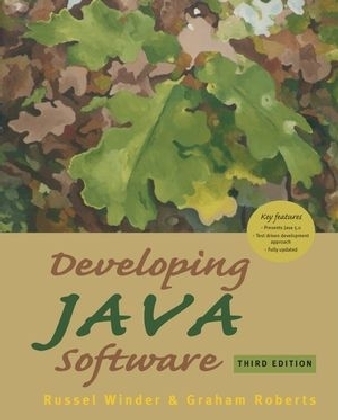
Developing Java Software
John Wiley & Sons Inc (Verlag)
978-0-470-09025-1 (ISBN)
Testing has always been an important part of Developing Java Software. This edition provides new chapters which give a detailed introduction to Test-driven Development (TDD). This approach to programming introduces more rigor to writing programs by placing emphasis on writing high quality testable and tested code from the outset. A series of examples and case studies shows how TDD works and highlights the strategies for testing code.
Reflecting recent changes to the Java programming language and newly focused on first courses in programming, this excellent primer is ideal for classroom use or self-study. The many motivating examples and larger case studies show how core ideas can be applied when creating real applications, and show how to use object-oriented methods effectively to create robust, reliable, and fully-tested Java applications.
Russel Winder was previously Professor of Computer Science and Head of Department at Kings College London. Graham Roberts lectures at Department of Computer Science, University College London, UK.
Preface. Part 1 Programming with Objects and Classes.
1 Introduction.
1.1 The Start.
1.2 A (Very!) Short History of Java.
1.3 Being at the Right Place at the Right Time.
1.4 What is Java?
1.5 Abstraction: The Critical Core of Programming.
1.6 The Java 2 Platform.
1.7 Java is Architecture Neutral.
1.8 Java and its Jokes.
1.9 Summary.
2 Programming Fundamentals.
2.1 Introduction.
2.2 Abstraction and the Big Picture.
2.3 Statement Sequences.
2.4 Iteration.
2.5 Selection.
2.6 State.
2.7 Writing a Simple Java Program.
2.8 Comments.
2.9 Output Statements.
2.10 Input Statements.
2.11 Interactive Programs.
2.12 Summary.
Self-review Questions.
Programming Exercises.
Challenges.
3 Adding Structure.
3.1 Introduction.
3.2 Abstraction and Encapsulation.
3.3 Methods.
3.4 Writing Programs with Methods.
3.5 Procedural Decomposition.
3.6 Encapsulation.
3.7 Some More Operators.
3.8 Some More Control Statements.
3.9 Some More Example Programs.
3.10 Summary.
4 Introducing Containers.
4.1 Introduction.
4.2 Arrays.
4.3 Container Classes.
4.4 Data Files.
4.5 Summary.
5 Drawing Pictures.
5.1 Introduction.
5.2 Creating Drawings.
5.3 Properties of Drawings.
5.4 Drawing Text.
5.5 Example Programs.
5.6 Summary.
6 Classes and Objects.
6.1 Introduction.
6.2 Creating New Data Types.
6.3 Generic Classes.
6.4 Method Names and Scope.
6.5 Object Initialization.
6.6 Objects and References.
6.7 Static Variables and Methods.
6.8 Example Classes.
6.9 Programming with Classes and Objects.
6.10 Enumerated Types.
6.11 An Example—Creating Bridge Hands.
6.12 Summary.
7 Class Relationships.
7.1 Introduction.
7.2 Association.
7.3 Inheritance.
7.4 Reuse: Inheritance vs. Association.
7.5 Inheritance Hierarchies.
7.6 Interfaces and Type Conformance.
7.7 Comparing Objects for Equality.
7.8 Nested Classes.
7.9 Packages.
7.10 Class Matrix Revisited.
7.11 Reusability and Components.
7.12 Summary.
8 Exceptions.
8.1 What’s the Problem?
8.2 Kinds of Errors.
8.3 Representing Exceptions.
8.4 Throwing an Exception.
8.5 Catching Exceptions.
8.6 The Finally Block.
8.7 Plan to Use Exceptions.
8.8 Some Examples.
8.9 Summary.
9 Introducing Concurrency with Threads.
9.1 Doing More Than One Thing At Once.
9.2 Threads.
9.3 Using Threads.
9.4 Thread Synchronization.
9.5 Thread Scheduling.
9.6 Example Programs.
9.7 Summary.
10 User Interfaces.
10.1 Introduction.
10.2 Core GUI Concepts.
10.3 Text Input with a GUI.
10.4 A Very Simple Text Editor.
10.5 Menus.
10.6 Painting.
10.7 Summary.
Part 2 The Process of Programming.
11 The Programming Process.
11.1 Introduction.
11.2 Why Object-oriented?
11.3 Development Tasks.
11.4 Testing Strategies.
11.5 UML Class, Object and Sequence Diagrams.
11.6 Practice and Experience.
11.7 Summary.
12 Unit Testing.
12.1 Introduction.
12.2 Unit Testing—A First Example.
12.3 The Core Principles of Unit Testing.
12.4 Test-driven Development.
12.5 The TestNG Framework.
12.6 Extending the Person Class.
12.7 Summary.
13 Test-driven Programming Strategies.
13.1 Introduction.
13.2 Getting Started—Searching for Files.
13.3 The GUI.
13.4 The Complete Searcher.
13.5 Summary.
14 Programming Tools.
14.1 Introduction.
14.2 Project Structure.
14.3 Ant—The Build Tool.
14.4 Version Control.
14.5 Integrated Development Environments.
14.6 Summary.
Part 3 Case Studies in Developing Programs.
15 Introducing the Case Studies.
15.1 Introduction.
15.2 The Case Studies.
15.3 The Presentations of the Case Studies.
16 Contacts Book.
16.1 Introduction.
16.2 Wading In.
16.3 Stepping Back—Some Research.
16.4 Data Storage.
16.5 A GUI Design.
16.6 Displaying the List of Contacts.
16.7 Menus and Action.
16.8 More to Do.
17 Pedestrian Crossing Simulation.
17.1 Introduction.
17.2 The Initial Problem Specification.
17.3 The Initial Thinking.
17.4 A First Pass.
17.5 Getting GUI.
17.6 GUIer and GUIer.
17.7 Control… We Have a Problem.
17.8 Onward.
17.9 Summary.
Part 4 The Java Programming Language in Detail.
18 A Java Language Reference.
18.1 Introduction.
18.2 Syntax and Semantics.
18.3 The Presentation.
18.4 The Example Programs.
18.5 Summary.
19 Variables, Types and Expressions.
19.1 Introduction.
19.2 Comments.
19.3 Identifiers.
19.4 Unicode Escapes.
19.5 Literals.
19.6 Types.
19.7 Scope.
19.8 Variables.
19.9 Expressions and Operators.
19.10 Source Files.
19.11 Summary.
20 Flow Control.
20.1 Introduction.
20.2 Selection.
20.3 Iteration.
20.4 Transfer Statements.
20.5 Recursion.
20.6 Summary.
21 Classes and Packages.
21.1 Introduction.
21.2 Classes.
21.3 Top-Level Classes.
21.4 Nested Classes.
21.5 Enumerated Types.
21.6 Packages.
21.7 Static Import.
21.8 Summary.
22 Inheritance and Interfaces.
22.1 Introduction.
22.2 Inheritance.
22.3 Interfaces.
22.4 Annotations.
22.5 Summary.
23 Exception Handling.
23.1 Introduction.
23.2 Summary.
24 Threads and Concurrency.
24.1 Introduction.
24.2 Class Thread.
24.3 Synchronized Methods.
24.4 Synchronized Statement.
24.5 Summary.
Part 5 Endmatter.
Appendix A Glossary.
Appendix B The CRC Method.
Appendix C The Online Documentation.
Appendix D Running Java Programs.
Appendix E Class Input.
Appendix F Class FileInput.
Appendix G Class FileOutput.
Appendix H Class DrawFrame.
Appendix I Class DrawPanel.
Appendix J Bibliography.
Index.
| Erscheint lt. Verlag | 20.10.2006 |
|---|---|
| Verlagsort | New York |
| Sprache | englisch |
| Maße | 189 x 233 mm |
| Gewicht | 1631 g |
| Themenwelt | Informatik ► Programmiersprachen / -werkzeuge ► Java |
| Mathematik / Informatik ► Informatik ► Web / Internet | |
| ISBN-10 | 0-470-09025-1 / 0470090251 |
| ISBN-13 | 978-0-470-09025-1 / 9780470090251 |
| Zustand | Neuware |
| Haben Sie eine Frage zum Produkt? |
aus dem Bereich


